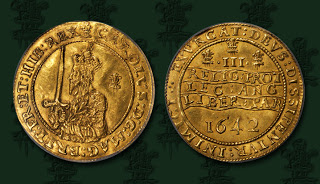
The coin’s reverse bears the date 1642 which would seem to make it impossible for it to have been minted at Oxford, as the mint master Thomas Bushell and his convoy of equipment from Shrewsbury did not arrive there until January 3, 1643. The reuse of 1642 dies seems a reasonable answer to this quandary except when you consider that the Welsh plumes used as mint marks at Shrewsbury would have been modified to appear as the Oxford plumes we see on this coin and in such a process the date surely would have been modified as well. The answer as it turns out is simply a matter of difference in the reckoning of the new year, since at this time in history the English reckoned the start of the new year not from January 1st but from Lady Day on March 25th. Thus this coin was minted during the nearly three-month period between the establishment of the mint in the New Inn Hall at Oxford at the beginning of January to nearly the end of March.
In our previous article on the Charles I Pound we discussed the inclusion of the abbreviated and Latin version of the Wellington Doctrine as the central element of the reverse design. Again we see it used on this large size gold piece. In addition to the Wellington Doctrine the reverse features an abbreviated Latin version of verse 1 of Psalm 68 (“Let God arise, let his enemies be scattered”). This legend first used at Shrewsbury gave Charles’ coinage its contemporary nickname “Exurgat money” and was yet another attempt to legitimize the King’s intentions as for the benefit of all and not solely his own. What is quite noticeable when you consider the legends on this coin is how clear and even the reverse appears, while the obverse has a fair amount of doubling. This effect comes from the method of hand striking employed to mint these coins. The obverse design would be engraved into a lower die called a pile, which had a long spike or burr at the base allowing it to be anchored to a work table, striking block, anvil or other surface. The upper die, called a trussel, bore the reverse design and would be fitted over the pile and struck directly with a hammer to create the impression. Due to the higher amount of stress the trussel would have to endure they wore out faster and thus would be switched out more often, usually with about two trussels to every pile. What we likely see on this Triple Unite is an obverse die exhibiting considerable wear while the reverse die had been swapped out relatively recently resulting in a much sharper image.
Another fantastic rarity from Charles I, this Triple Unit is incredible in its beauty and craftsmanship, particularly when one considers that the Royal mints at this time were being moved and/or newly established quite often. An early issue from the King’s mint of Oxford, Charles I gold coinage doesn’t come much rarer than this. Look for this piece and many other rarities at the Stack’s Bowers & Ponterio auction at the August ANA 2012 Convention in Philadelphia





